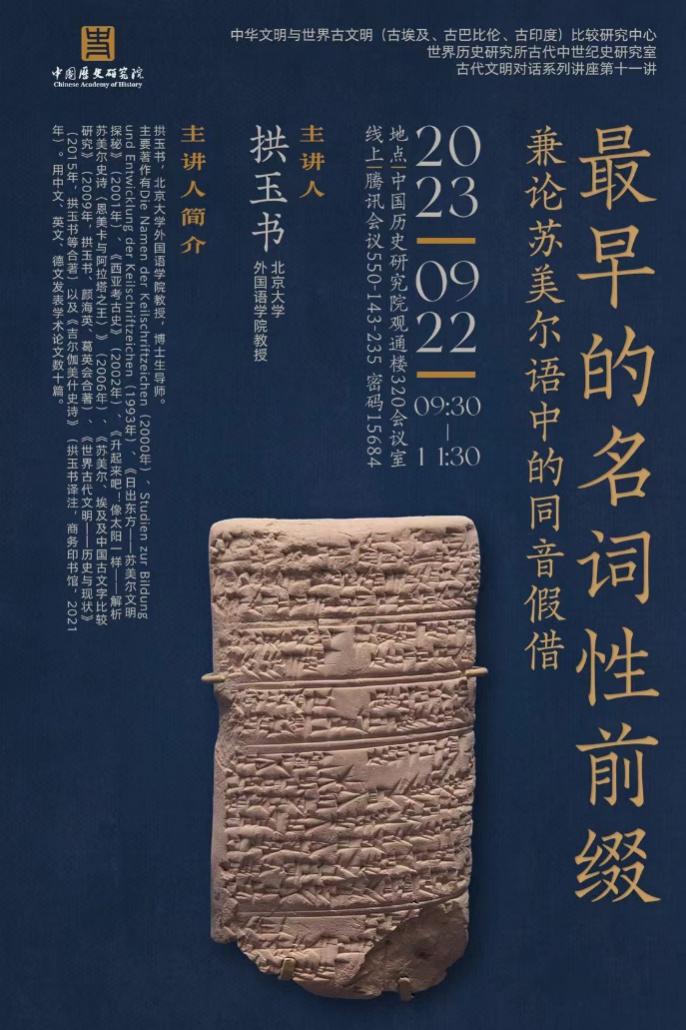世界史所邀请拱玉书教授作学术报告
2023-10-23
2023年9月22日上午,北京大学外国语学院西亚系、北京大学东方文学研究中心拱玉书教授应邀到世界历史研究所,在320会议室作了题为“最早的名词性前缀——兼论苏美尔语中的同音假借”的讲座。本讲座是“古代文明对话”系列讲座第十一讲,由中国历史研究院中华文明与世界古文明(古埃及、古巴比伦、古印度)比较研究中心与世界历史研究所古代中世纪史研究室联合主办。讲座同时在线上进行,来自全国科研机构和高校的众多学者和学生参加。

拱玉书教授首先简要介绍了苏美尔语名词的前缀,主要考证了苏美尔语名词前经常出现的nam这一语素的来源和性质,并深入探讨了由此引申的苏美尔语同音假借现象。拱玉书教授首先讨论了nam出现在名词之前的情况。在两河流域古代文献《伊楠娜与恩基》中,恩基将一系列职权赐予女神伊楠娜,这其中就有以nam开头的名词,例如nam-dingir“神性”,nam-sipad“牧羊权”,nam-lugal“王权”等。此外,词表文献中也经常发现一系列以nam开头的名词。除了名词,nam也可以放在形容词之前,将形容词变为抽象名词,如nam-galam是“艺术性”的意思。nam还会出现在动名词前,将动词变为抽象名词,如nam与表示“打”的动名词tag-ga结合成nam-tag-ga,表示“惩罚”。
就如何解释名词前的nam,现代学者有着不同的意见。一些学者认为,nam是名词前缀。还有一些学者认为nam并非前缀,而是一个单独的词,表示“命运”“状态”的意思。其他学者的观点模棱两可。

拱玉书教授认为,nam是不能独立存在的前缀,只能位于名词、形容词或动名词之前,其功能是把词根抽象化。在苏美尔语文献中,nam虽然位于名词之前,但并不与名词相结合组成复合词,而是改变名词所表达的意思。阿卡德语文献也不把nam作为实词,而是将以nam开头的苏美尔名词处理为抽象名词,即阿卡德语以utum结尾的词,或用意思相近的词表达。对于难以用阿卡德语表达的苏美尔抽象名词,还会采用不翻译而直接使用的办法。这就说明,古人在使用和认识nam时,是将其作为前缀来看待的。
nam作为前缀,其起源是与苏美尔语中的同音假借现象密切相关的。同音假借的用法在苏美尔语文献中很常见。苏美尔书吏在书写时常常借用发音相同的楔形文字符号来拼写某个词。nam这一前缀最早使用的是nam2这一符号。早在乌鲁克文化四期的“人表”之中,nam2就出现在一系列名词之前。早王朝时期,人们开始使用楔形文字符号nam来代替nam2。通常所说的nam2和nam表示“确定的秩序”或“事物的性质”的意思,是现代学者从其作为前缀的作用中概括出来的,并不是这个词本身的含义。

从本质上说,nam的概念是苏美尔哲学的伟大构想。苏美尔人在认识客观世界时,虽然没有形成理论,但产生了一些固定的表达方式。nam关注人类文明要素和创造文明的人,以及主宰人类的神,是早在文字产生之前就存在于口语中的一个语素。在文字产生后,人们才开始用发音相近的楔形文字符号来作为这一语素的可视符号。
讲座之后,世界历史研究所刘健研究员对拱玉书教授的讲座内容和主要观点进行了总结。拱玉书教授与古代中世纪史研究室的各位老师和中国社会科学院大学的同学进行了热烈讨论,也对线上观众提出的问题进行了解答。
(中国社会科学院世界历史研究所古代中世纪史研究室 温静供稿、供图)
Lecture on the Earliest Nominal Prefix and the Use of the Loaned Homophones in Sumerian by Professor Gong Yushu, Peking University
Wenjing Reports: On September the 23rd, 2023, the Department of Ancient and Medieval History, the Institute of World History (IWH), and the Center for Comparative Studies of Ancient Civilizations, Chinese History Academy (CCSAC), invited Dr. Gong Yushu, Professor of Assyriology, Peking University, to give a lecture entitled “The Earliest Nominal Prefix and the Use of the Loaned Homophones in Sumerian.”
Professor Gong Yushu briefly introduced the prefixes of Sumerian nouns and investigated the origin and nature of NAM, a morpheme that frequently appeared before Sumerian nouns. He also discussed the use of the loaned homophones in Sumerian from which NAM derived.
Professor Gong Yushu believes that NAM is a prefix that cannot occur independently. It always appears before a noun, an adjective, or a gerund to generate an abstract meaning from the word root. In Sumerian literature, NAM preceding a noun does not form a compound word but changes the meaning of the noun to an abstract one. The origin of NAM as a prefix is closely connected to the phenomenon of the widely used loaned homophones. As early as Uruk IV period (ca. 3200 B.C.), the cuneiform sign NAM2 appeared before a series of nouns in the archaic Lu2 list. During the Early Dynasty, people started to use NAM instead of NAM2.
Professor Gong Yushu suggests that the concept of NAM is a great conception of the Sumerian philosophy. When the Sumerians were trying to understand the material world, they molded some fixed expressions before the development of any philosophical theory. NAM is an exemple to focus on the elements of human civilization and the people who created it, as well as the deities who rule over mankind. It existed as a morpheme in spoken language long before the invention of writing. Only after the development of a writing system, people began to use signs with similar pronunciation as visual symbols for this morpheme.
After the lecture, Professor Gong Yushu had a warm discussion with the members of the Department of Ancient and Medieval History and students from the University of the Chinese Academy of Social Sciences, and also answered the questions raised by the online audience.

